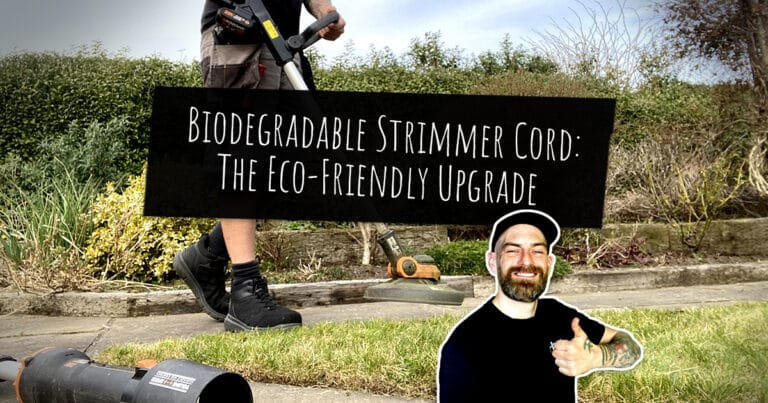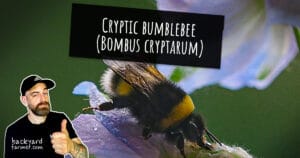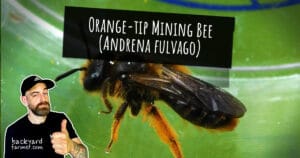Table of contents
Introduction
Every time you fire up your strimmer to tidy up the lawn or neaten the edges, you’re likely leaving behind more than just trimmed grass. Traditional strimmer cord, especially non-biodegradable types, is made from nylon — a tough, synthetic plastic that sticks around far longer than it should. Bit by bit, it sheds into your soil, quietly feeding the microplastic problem we’re all trying to move away from.
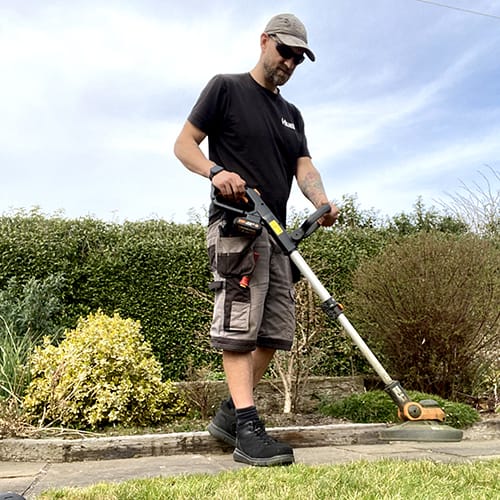
As someone who works the land day in, day out, I try to keep things as natural and low-impact as I can. But one thing that’s never sat right with me is using plastic strimmer line. It feels wrong knowing each cut sends a trail of tiny plastic fibres out into the world — invisible to the eye, but no less real.
It might seem like a small thing, but over the course of a season, it builds up. Most of us wouldn’t chuck plastic into our compost, but nylon line sneaks in under the radar — shredded, scattered, and forgotten. That’s why I started looking for something better.
Enter biodegradable strimmer cord. These eco-friendlier alternatives are made from compostable, plant-based materials like PLA or biopolymers. They’re designed to break down properly in soil or compost-like conditions, leaving behind nothing but organic matter.
What this guide covers
- What biodegradable strimmer cord actually is
- How well it stacks up against regular nylon
- The best options available to UK gardeners in 2026
Whether you’re keeping on top of an allotment or just taming the garden borders, switching to a greener line like biodegradable strimmer cord is one of the easiest upgrades you can make this year.
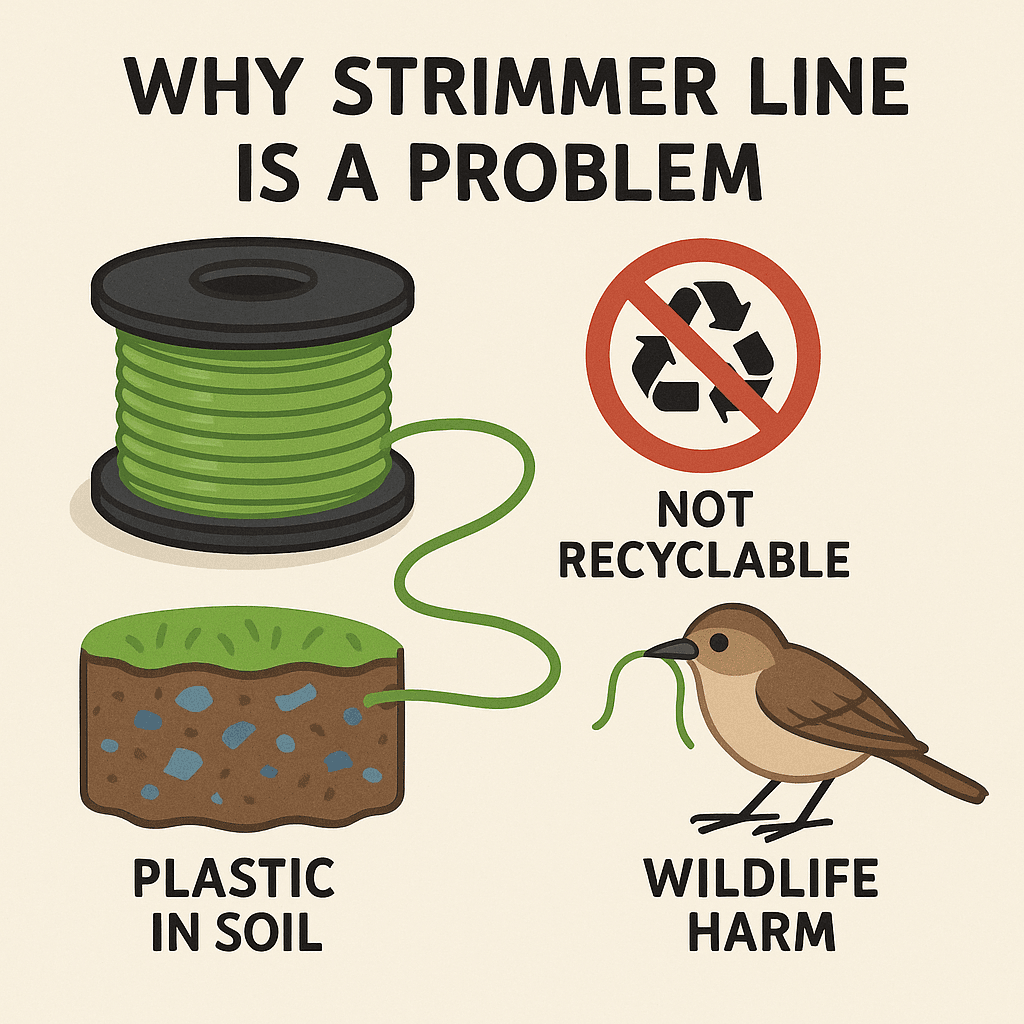
Why Traditional Strimmer Line Is a Problem
Most gardeners don’t think twice about the strimmer line they use — it’s just a spool of plastic that keeps things tidy, right? I used to think the same, until I realised what it’s actually made from. Most of it is nylon, a synthetic plastic chosen for its strength and durability. But that same toughness is exactly what makes it such a long-term environmental problem.
It Doesn’t Break Down
Once a piece of nylon line snaps off, it doesn’t go anywhere. It doesn’t rot like wood or vanish like clippings — it just sits in the soil, breaking into smaller pieces year after year. Before long, you’ve got a garden that’s quietly collecting plastic, and you’d never even know it.
It Adds Microplastics to the Soil
Every time the strimmer whirs up, tiny fibres of plastic get scattered across your borders. These microplastics are far too small to spot, but they:
- Interfere with the natural structure of the soil
- Can be eaten by worms and insects
- Eventually work their way into local ecosystems
It Can’t Be Recycled or Composted
There’s no real way to dispose of used strimmer line responsibly. You can’t recycle it, and you definitely can’t compost it — unless you want plastic in your veg beds. It ends up in landfill, or worse, scattered around your patch unnoticed.
It Harms Wildlife
Bits of plastic in hedge clippings or long grass can be picked up by birds or small mammals. If that waste is composted off-site or washed away in a heavy rain, it can end up in rivers and streams. What starts as a neat job around the edges can quickly ripple outward.
The bottom line? Strimmer line might seem harmless, but over time it leaves a lasting mark. As someone who works close to the ground every day, I reckon it’s time we start rethinking the tools we use — and start looking at better options like biodegradable strimmer cord instead.
What Is Biodegradable Strimmer Cord?
Biodegradable strimmer cord is a solid alternative to the usual nylon stuff — but with a much cleaner conscience. Unlike plastic line that hangs around for decades, this stuff is made to break down naturally over time. It does the job, but without leaving a plastic trail behind.
These cords are made using materials like PLA (polylactic acid), biopolymers, or corn-based resins — all designed to return to the earth instead of sticking around in it.
What It’s Made From
- PLA (Polylactic Acid): A plant-based material made from things like corn starch or sugarcane. It’s the same kind of thing you find in compostable cups and packaging.
- Bioplastics/Resins: Some companies blend natural fibres with compostable polymers to make the cord a bit tougher.
- Oxo-biodegradable blends: These contain chemical additives that help the plastic break down quicker. They’re better than pure nylon but still not perfect — microplastics may stick around.
How It Breaks Down
When you give it the right conditions — heat, moisture, and plenty of microbial life — biodegradable strimmer cord starts to break down into natural ingredients:
- Carbon dioxide (CO2)
- Water
- Humus (basically soil food)
It’s a far cry from nylon, which just splinters and lingers. This stuff disappears without leaving a trace. 🔍 Curious about what happens to traditional cord? Read the full breakdown in Does Nylon Trimmer Line Biodegrade? (And Why It Matters) to see why switching really matters.
Soil vs Marine Biodegradable
Some lines are designed to break down in soil only, while others also degrade in water. That’s handy if you’re working near streams, ditches, or ponds. Keep an eye out for labels like ASTM D6400, D5988, or EN13432 — they mean the product’s genuinely compostable.
How Long Does It Take?
- Anywhere from 6 to 24 months, depending on what it’s made of and where it ends up
- Breaks down quicker in warm, moist compost
- Slower in cold or compacted soil
In a nutshell: biodegradable strimmer cord does everything nylon does, but it won’t leave a mess behind. If you’re already trying to keep your garden low-impact, this is a great place to start.
The Best Biodegradable Strimmer Cord Brands (2026 Picks)
There aren’t loads of biodegradable strimmer cords on the market yet, but the ones that are out there are making a solid name for themselves. Whether you’re just pottering around the garden or doing regular work on the allotment, these options are a step in the right direction if you’re looking to ditch plastic.
Sustainaline (by Weed Recede)

- Type: Soil + marine biodegradable
- Material: Corn-based PLA blend
- Breakdown: Fully degrades into humus, CO2, and water in composting conditions
- Certifications: ASTM D5988 and D6691
- Availability: Currently US-based only — no UK stockists yet
- Why it stands out: One of the few options made to break down both in soil and water. It sets the bar high for what sustainable strimmer line can look like.
GreenLine (by Senbis)
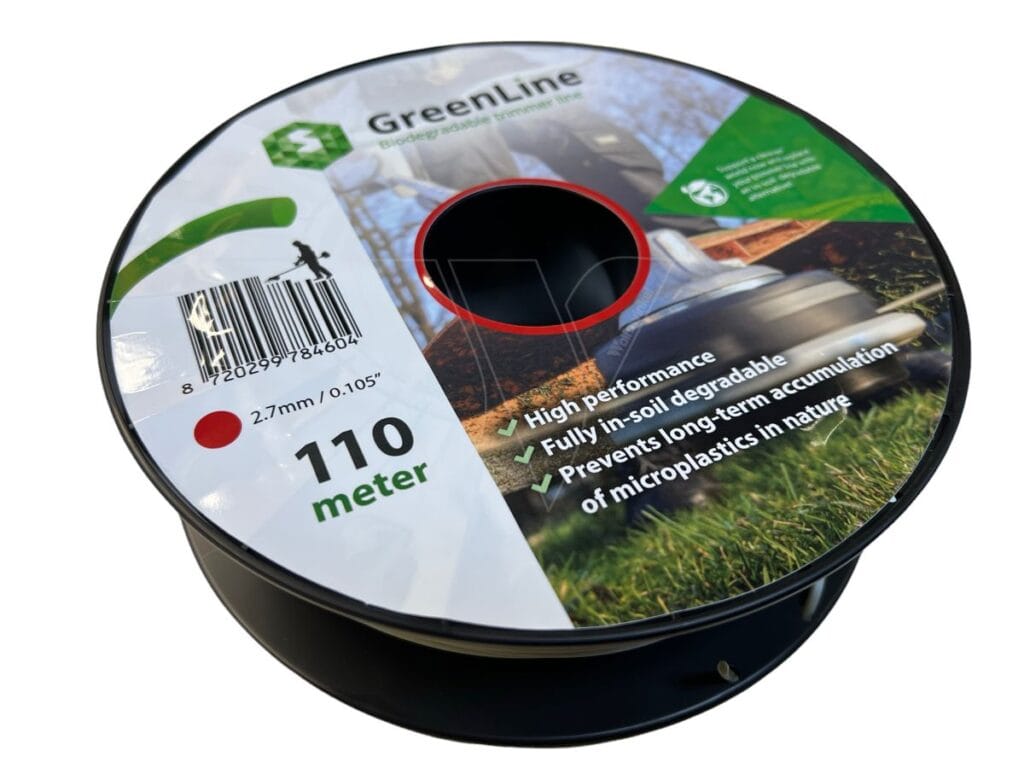
- Type: Soil biodegradable
- Material: PLA biopolymer
- Breakdown: Breaks down completely in active, healthy soil
- Certifications: EN13432 and ISO 17556
- Availability: Limited UK access — usually via direct order or EU garden suppliers
- Why it stands out: Created by a Dutch team focused on compostable agriculture products. Genuinely breaks down, not just a green label.
Biotrim (by Oregon)
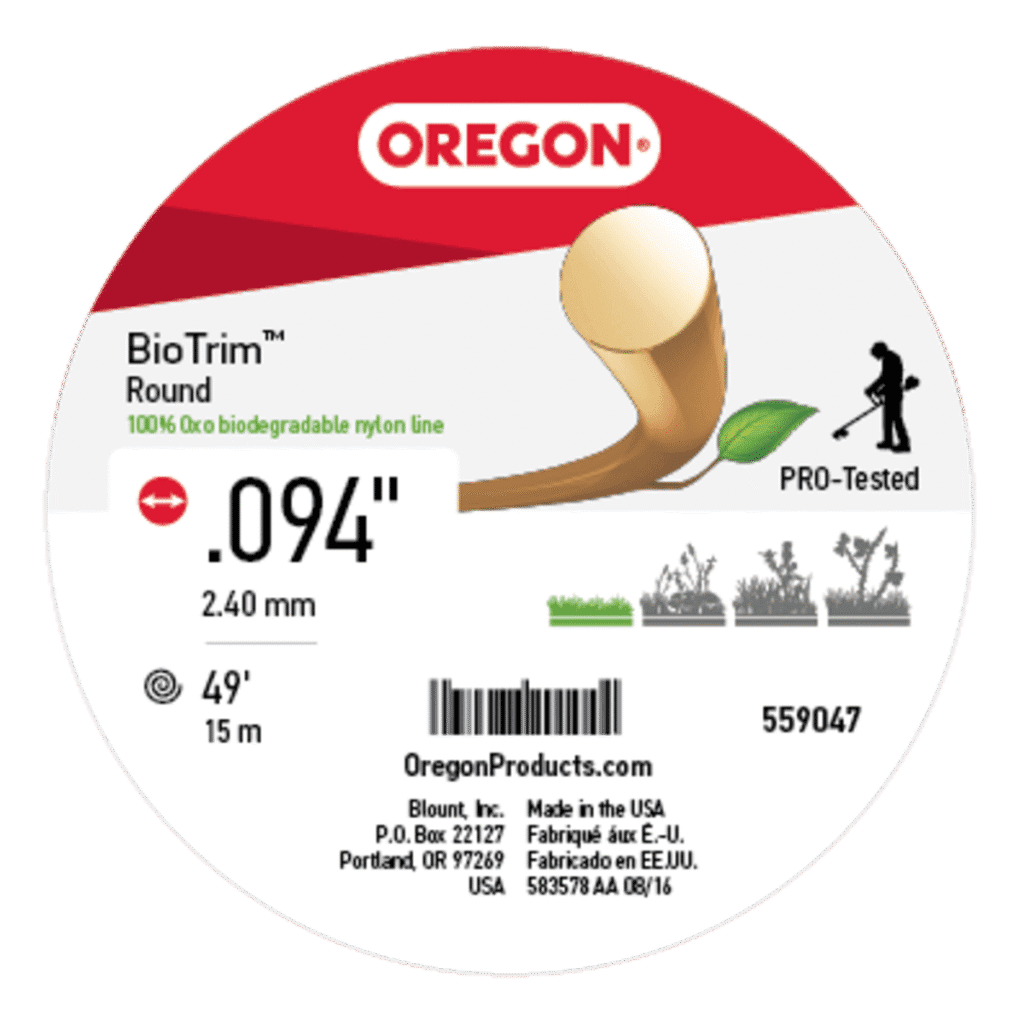
- Type: Oxo-biodegradable
- Material: Nylon with a degrading additive
- Breakdown: Starts breaking down within 12–24 months
- Certifications: Not fully compostable — only partial breakdown
- Availability: Easy to find on eBay (affiliate)
- Why it stands out: Not perfect, but better than standard nylon. A decent upgrade that’s readily available in the UK.
Shakespeare Impact Biodegradable Line
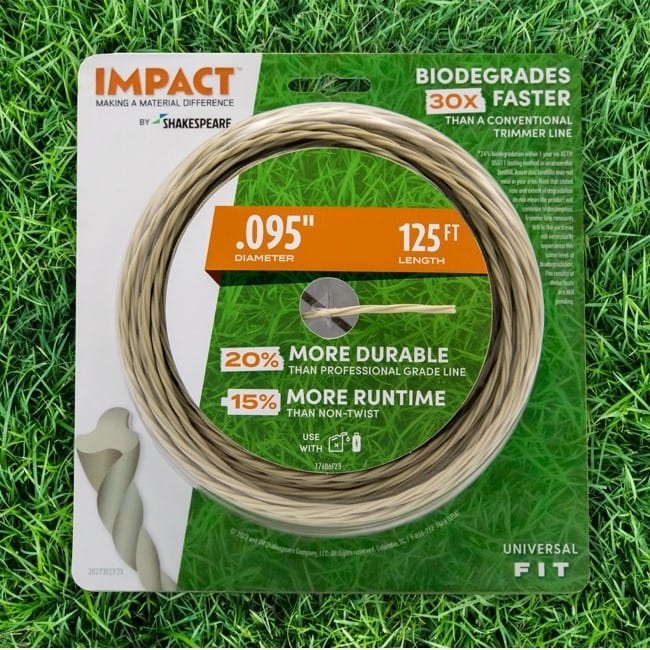
- Type: Faster-degrading nylon alternative
- Material: Proprietary hybrid polymer
- Breakdown: Fragments and degrades faster than nylon, though not truly biodegradable
- Certifications: None
- Availability: Available through Amazon UK (affiliate)
- Why it stands out: It’s not the greenest, but it’s out there and easy to get hold of — which counts for something when you’re mid-job and out of line.
Availability and compostability vary, but all of these biodegradable strimmer cord options beat standard nylon by a mile. Even a small change like this, if you’re trimming regularly, can seriously cut down on the plastic you leave behind.
If you’re looking for a lightweight cordless trimmer to pair with biodegradable line, check out my full WORX WG163E review — it’s a solid option for eco-conscious gardeners.
Does Biodegradable Line Actually Work?
Eco-friendly tools sound great — but do biodegradable strimmer lines actually hold up in the real world? In my experience, the answer is yes. They can do the job just fine, especially if you’re clear about what they’re built for. Like anything in the garden shed, it’s about using the right tool for the task.
Strength & Cutting Power
Most biodegradable lines perform much like standard nylon when it comes to everyday jobs:
- Edging lawns
- Knocking back light weeds
- Tidying paths and borders
That said, they’re not quite as tough as the heavy-duty nylon stuff. So, if you’re strimming through brambles, thick dock, or anything woody, expect them to wear down a bit quicker. For lighter maintenance, though, they hold up well.
Performance in Wet Conditions
They’ll cope with a damp morning or a bit of drizzle without falling apart. But lines made from PLA or biopolymer blends can soften if stored in damp conditions. I keep mine sealed in a tub or hung somewhere dry — just like I do with seed packets or twine.
Breakdown Process
Now, they don’t start breaking down the minute they hit the ground — and that’s a good thing. To properly degrade, they need:
- Moisture
- A decent amount of microbial life
- A bit of warmth (ideally 15–30°C)
In active compost or healthy topsoil, they’ll usually start to break down within 6–12 months. In colder or compacted soils, it takes longer — but crucially, unlike nylon, they will eventually disappear.
What About Oxo-Biodegradable Lines?
Brands like Biotrim add chemicals that speed up fragmentation. These are better than standard nylon, sure, but they can still leave microplastics behind. So they’re a halfway step, not a full solution.
Bottom line? If you’re a home gardener, an allotmenteer, or just trying to cut back on plastic, biodegradable line is a solid upgrade. It won’t suit every rough job, but for routine work, biodegradable strimmer cord gets the job done — without leaving a mess behind.
Where to Buy Biodegradable Strimmer Cord in the UK
As of 2025, biodegradable strimmer cord is still a bit of a hidden gem — but if you know where to look, there are a few decent options available in the UK. Here’s a breakdown of the best places to check if you’re looking to trim up without leaving a plastic trail.
Amazon UK
- Shakespeare Impact Line is the easiest one to get hold of.
- It’s not fully biodegradable, but it does break down faster than standard nylon.
- Available with Prime delivery and usually fairly priced.
eBay UK
- eBay’s a good shout for Biotrim, and sometimes you’ll find GreenLine too.
- Listings change often, so it’s worth reading the product details carefully.
- Handy for trying a roll or two before committing to a bulk buy.
Manufacturer Websites
For the truly sustainable options — like Sustainaline and GreenLine — you’ll usually need to order direct or through a specialist:
- Weed Recede (Sustainaline): weedrecede.com
- Senbis GreenLine: https://bio-greenline.com/en/products
Postage can be slower and pricier, but in return you’re getting properly compostable, certified gear that walks the walk.
B&Q, Screwfix, and Garden Centres
- At the moment, none of the major UK retailers stock genuinely biodegradable line.
- You might see some oxo-degradable or “eco” options, but they don’t fully break down — check those labels carefully.
- That said, this space is changing fast. If enough of us ask, retailers will start stocking better options.
Pro tip: Once you find a biodegradable strimmer cord that works for you, grab a couple of spools. Stock can be patchy, and having a spare on hand means you’re sorted for the season — without ever reaching for plastic line again.
FAQs
Standard nylon strimmer line doesn’t break down — not in your compost bin, and not in the soil either. It lingers for years, slowly turning into microplastics. On the other hand, biodegradable strimmer cord is designed to break down into organic matter — but only when the conditions are right. It needs a bit of warmth, some moisture, and a healthy dose of microbes to get going.
The usual stuff is nylon — tough, durable, and definitely not eco-friendly. Biodegradable options, however, are made from PLA, bioplastics, or oxo-biodegradable blends. These materials were developed to reduce long-term waste and offer us more sustainable choices in the garden.
In theory, yes — but it depends on the type of compost system you’ve got. If it’s hot and active, or you’re using an industrial composting service, some eco lines will break down. Look out for proper certifications like ASTM D6400, EN13432, or ISO 17556 — they’re your sign the product can actually compost. If your bin runs cool and slow, it might take a long time to disappear.
Oxo-biodegradable cords have additives that help them fragment faster when exposed to sunlight and oxygen. Better than nylon, but they may still leave microplastic bits behind.
Fully biodegradable cords are designed to return to the earth as CO₂, water, and humus, leaving nothing nasty behind.
Absolutely. Most biodegradable cords work just fine with petrol, electric, and battery-powered strimmers. Just make sure the cord diameter matches your spool. If you’re tackling anything heavy-duty, go for a thicker line or double up for a bit of extra bite.
Got a question that’s not listed here? Drop me a message or leave a comment — always happy to help you find the right biodegradable strimmer cord for your garden.
Final Thoughts: A Small Switch, a Big Win for the Planet
We all want to keep the garden looking tidy, but that doesn’t mean we need to rely on plastic that sticks around forever. Swapping out your old nylon strimmer line for a biodegradable version is a simple change — one that quietly makes a big difference over the course of a season.
From my own experience, it’s the little choices that start to add up. Switching to compostable line doesn’t just cut down on microplastics — it also means you’re strimming with something that eventually gives back to the soil, not clogs it up. It’s not about being perfect, but about doing better where we can.
If you’ve never tried one before, I’d say just give it a go. Pick up a spool, fit it to your strimmer, and see how it holds up in your garden. Biodegradable strimmer cord performs — and you might be surprised how good it feels to stop flinging plastic into the beds.
Try something greener. Share what you find. And let’s keep growing gardens we can feel good about.
